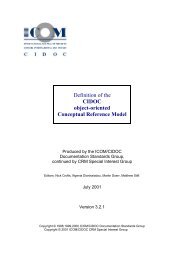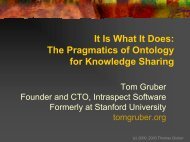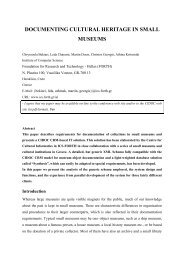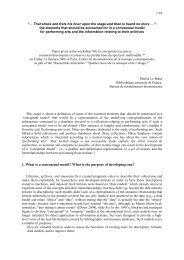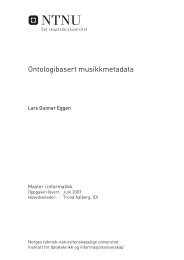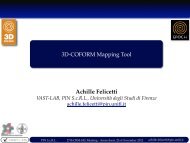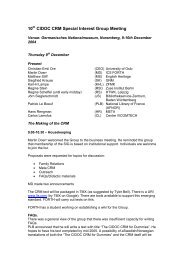to it. So, <strong>for</strong> example, Marx considered the “alienation problem” to be rooted in “economy”,while Searle treats the “mind-body problem” within the “philosophy of mind”. <strong>The</strong>re<strong>for</strong>e, theproblem exists within a problem-area. Moreover, the context which makes us underst<strong>and</strong> aproblem is given also by the set of assumptions that justify its existence. Or better, by theviews <strong>and</strong> arguments that define it (<strong>and</strong>, conversely, try to solve it). <strong>The</strong> remainingproperties of problem, as shown below, relate them to other problems or to the view <strong>and</strong>arguments that tackle them.A special role is held by the property has-problem-type, which can have value “openproblem”(meaning a problem which does not have any solution), “multilemma” (a problemhaving or allowing multiple solutions), “dilemma” (a problem allowing two solutions only,but neither of the two being satisfactory) <strong>and</strong> “paradox” (a problem whose solutions seemequally plausible, but when considered together generate a contradiction). Essentially,these concepts describe a problem from the viewpoint of the number of solutions it has.We have modeled them as instances of the class problem-type (which is not in thephilosophical-idea branch, but is instead a subclass of <strong>CIDOC</strong>ʼs type), since they do notappear to be ʻessentialʼ <strong>for</strong> the definition of a problem, but just accidentally related to theexistence of any solution. In other words, a definitional-problem (see below) will alwaysmaintain its structure, regardless of being an “open-problem” (i.e. having no solutions) or a“multilemma” (i.e. having various solutions).From the analysis of the literature we thought it was useful also to provide a classificationof problems based on their morphology. That is, on their external structure, which can besometimes related to their content, but is usually independent from it. In total, we identified6 ʻmorphological typesʼ of problems:1) the existence-problem has usually the <strong>for</strong>m "Does X exist?"; specializations areexistence-as-concrete-problem ("Is X concrete/real?") <strong>and</strong> existence-as-abstractproblem("Is X abstract?")2) the definitional-problem has usually the <strong>for</strong>m "What is X?". Specializations aredefinitional-problem-essence ("what are the characteristic traits X has?"),definitional-problem-attribute ("what are the attributes X has?") <strong>and</strong> compositionproblem("What is X composed of?")3) the functional-problem has usually the <strong>for</strong>m "What is the function of X?"; the onlyspecialization is purpose-problem ("What is the purpose of X?")4) the relational-problem has usually the <strong>for</strong>m "What is the relation between X <strong>and</strong> Y?";specializations are dependence-problem ("Are X <strong>and</strong> Y dependent?"), dependence-causeproblem("Is X the cause of Y?"), dependence-effect-problem ("Is X the effect of Y?"),independence-problem ("Is X independent from Y?"), equality-problem ("Is X equal toY?") <strong>and</strong> difference-problem ("Is X different from Y?").5) the modality-problem is a problem about the degree of certainty X is likely to happen(or not). Specializations are necessity-problem ("is X necessary?"), possibility-problem("is X possible?"), contingency-problem ("is X contingent?") <strong>and</strong> impossibility-problem("is X impossible?")
6) the factual-problem has the <strong>for</strong>m "how, in what way does X happen, or manifestsitself?".At the time of writing, we are instantiating these problem templates by filling the emptyspaces in the question with instances of concept. For example:(def-instance what-is-virtue definitional-problem((contains-concept virtue)(has-problem-type multilemma)(exists-in-area ethics)(related-to-problem what-is-value)(is-tackled-by-View Plato-philosophy Aristotle-philosophy stoic-philosophy)(linked-to-fact death-of-socrates)))A much more interesting solution would be instead letting any instance of philosophicalideabe filling those spaces. This would result in a powerful reification mechanism: e.g. wecould define a problem about the relation between two other problems. Moreover, we arealso investigating how to use these structures <strong>for</strong> producing inferences (e.g. from arelational-problem, we can create a path which links to the definitional-problems ofthe concepts related). <strong>The</strong>se <strong>and</strong> other issues (such as how to classify problems accordingto their ʻcontentsʼ e.g. "moral problem" or "epistemological problem") will be investigated infuture research.3.4 MethodVarious ontologies introduce a class named ʻprocedureʼ, with reference to any sequencelikespecification. Similarly, a heuristic or method in philosophy is essentially defined as aseries of steps leading from a problem towards its solution. Depending on whether themethod suggests a practical activity, or an intellectual one, we classified instances asbelonging to abstract-method or practical-method (see fig. 7).<strong>The</strong> main types of abstract-method are logical-mathematical-method, rule-ofinference<strong>and</strong> argumentative-method. <strong>The</strong> first one subsumes algorithm <strong>and</strong> comprisesinstances such as “the quick-sorting algorithm”, Wittgensteinʼs “truth-table method” orLeibnizʼs “infinitesimal calculus”. <strong>The</strong> second class refers to rules that are used to justifythe steps in a <strong>for</strong>mal proof of the validity of a more complex argument. For example, wecan have “modus ponens”, “hypothetical syllogism”, “conjunction”, “double-negationelimination” etc. <strong>The</strong> class fallacy, instead, refers to invalid argumentative steps that mayappear convincing at first glance because they closely resemble legitimate patterns ofreasoning. For example, fallacies can be the “illicit major”, “affirming the consequent”,“denying the antecedent”, “affirming the alternative” etc. Finally, the class argumentativemethodcategorizes famous <strong>and</strong> well-established argumentation styles, such as “deductiveargument”, “argumentum a <strong>for</strong>tiori”, “argumentum ad hominem”, “argumentum adpopulum” etc.



